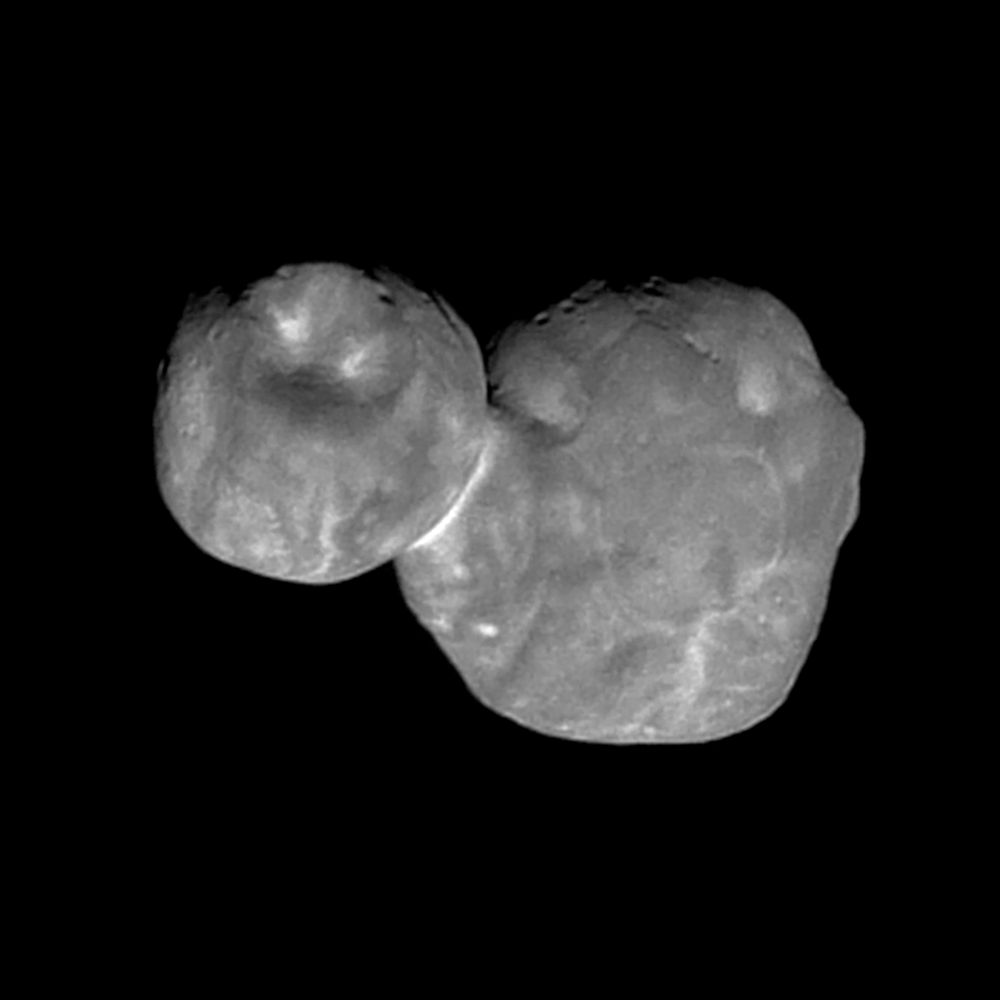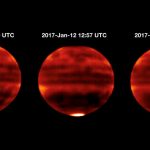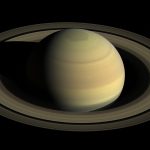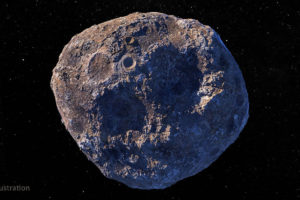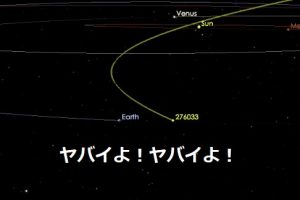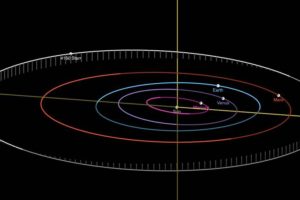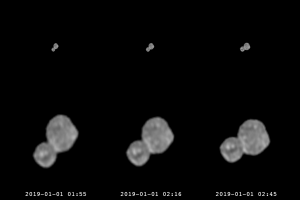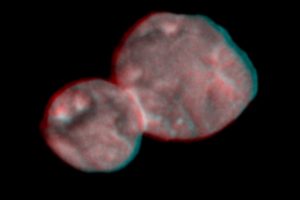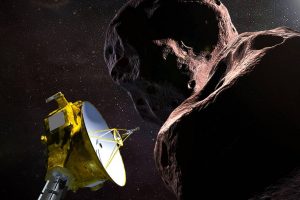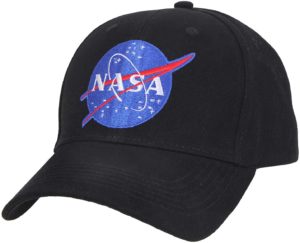NASAがニューホライズンズから送られてきた最も新しく、最も高画質の画像を公開しました。
Image credit: NASA/Johns Hopkins University Applied Physics Laboratory/Southwest Research Institute
NASAの記事の原題は以下となります。
New Horizons’ Newest and Best-Yet View of Ultima Thule
記事URL:http://pluto.jhuapl.edu/News-Center/News-Article.php?page=20190124
この記事(最新画像)でのポイントは2つ。
2つの天体は地質学的に異なる(なので、どうしてくっついているのか更に謎が深まった)
特徴的な明暗の模様が見える。これがこの2つの天体の成り立ちを解くヒントになるかもしれない
なお、来月(2019年2月)にさらに高解像度でカラーの画像を公開するとのことです。
また、現在ニューホライズンズは地球から 約66.4億キロの地点を時速50,700キロ以上の速度で遠ざかっており、地球までのデータ送信に6時間9分かかっているそうです。
以下にオリジナル記事と和訳(参考)を掲載します。
ニューホライズンズから送られてきたUltima Thule(ウルティマ・トゥーレ)の最新かつ最高画質の画像
The wonders – and mysteries – of Kuiper Belt object 2014 MU69 continue to multiply as NASA’s New Horizons spacecraft beams home new images of its New Year’s Day 2019 flyby target.
NASAの探査機ニューホライズンズが2019年の元旦にカイパーベルトの天体 2014 MU69 に最接近した際に撮影した画像により、この不思議な天体 – そして謎 – はさらに深まるばかりです。
This image, taken during the historic Jan. 1 flyby of what’s informally known as Ultima Thule, is the clearest view yet of this remarkable, ancient object in the far reaches of the solar system – and the first small “KBO” ever explored by a spacecraft.
この画像は、非公式名称ではありますが「Ultima Thule(ウルティマ・トゥーレ)」として知られている天体に、この1月1日に歴史的な接近をした際に撮影されたものです。この画像は、太陽系から遠く離れたところに存在している太古の天体の今まで撮影されたことのない非常に鮮明な画像であり、探査機が「KBO(カイパーベルトの天体)」の探査をするのは人類初のことです。
Obtained with the wide-angle Multicolor Visible Imaging Camera (MVIC) component of New Horizons’ Ralph instrument, this image was taken when the KBO was 4,200 miles (6,700 kilometers) from the spacecraft, at 05:26 UT (12:26 a.m. EST) on Jan. 1 – just seven minutes before closest approach. With an original resolution of 440 feet (135 meters) per pixel, the image was stored in the spacecraft’s data memory and transmitted to Earth on Jan. 18-19. Scientists then sharpened the image to enhance fine detail. (This process – known as deconvolution – also amplifies the graininess of the image when viewed at high contrast.)
ニューホライズンズに搭載している観測装置Ralphの広角カラーカメラ(MVIC)で撮影したこの画像は、1月1日の最接近の7分前にあたる05:26 UT( 12:26 a.m. EST )に探査機がKBOから4,200マイル(6,700 km)の地点から撮影したものです。 画像の解像度は1ピクセルあたり440フィート(135 m)で、撮影データはいったん探査機のデータメモリに保存され、1月18日から19日にかけて地球に送られてきました。その後、科学者たちは細部を強調するため画像処理を加えています。 (この画像処理はデコンボリューションとも呼ばれ、コントラストが高い画像の画素の粒度を大きくするものです)
The oblique lighting of this image reveals new topographic details along the day/night boundary, or terminator, near the top. These details include numerous small pits up to about 0.4 miles (0.7 kilometers) in diameter. The large circular feature, about 4 miles (7 kilometers) across, on the smaller of the two lobes, also appears to be a deep depression. Not clear is whether these pits are impact craters or features resulting from other processes, such as “collapse pits” or the ancient venting of volatile materials.
この斜めから光を当てたような画像では、先端付近の境界線から光の当たる昼と夜との境に沿って、地形の詳細な状態をよく観察することができます。これらの直径が約0.4マイル(0.7キロメートル)の多くの小さな陥没があることがわかります。 2つくっついたような天体のうちの小さい方は、幅が約4マイル(7キロメートル)という大きな円形をしていて、大きなくぼみがあります。これらの特徴は、隕石の衝突によるクレーターなのか、「地殻崩壊による穴」や太古の時代に揮発性物質を放出した跡なのか、あるいは他の原因によるものなのか、今のところはわかっていません。
Both lobes also show many intriguing light and dark patterns of unknown origin, which may reveal clues about how this body was assembled during the formation of the solar system 4.5 billion years ago. One of the most striking of these is the bright “collar” separating the two lobes.
この2つの天体とも原因不明の多くの興味深い明暗模様を示しています。そしてそれは、45億年前の太陽系が形成される際にこの体がどのようにして出来たのかについての手がかりになるかもしれません。この中で最も明るく見えているのは2つの天体の間にある「襟」にような部分です。
“This new image is starting to reveal differences in the geologic character of the two lobes of Ultima Thule, and is presenting us with new mysteries as well,” said Principal Investigator Alan Stern, of the Southwest Research Institute in Boulder, Colorado. “Over the next month there will be better color and better resolution images that we hope will help unravel the many mysteries of Ultima Thule.”
コロラド州ボルダーのサウスウェスト研究所の上級研究者アラン・スターンは、「この新しい画像は、 Ultima Thule(ウルティマ・トゥーレ) の、どうして地質学的に異なる2つの天体がくっついているのかという新たな謎を示しています。」と述べました。 「来月には、 Ultima Thule(ウルティマ・トゥーレ) の 多くの謎を解明するのに役立つ、より解像度の高いカラー画像が得られる予定です。」
New Horizons is approximately 4.13 billion miles (6.64 billion kilometers) from Earth, operating normally and speeding away from the Sun (and Ultima Thule) at more than 31,500 miles (50,700 kilometers) per hour. At that distance, a radio signal reaches Earth six hours and nine minutes after leaving the spacecraft.
ニューホライズンズは地球から約41.3億マイル(66.4億キロ)の地点を、時速31,500マイル(50,700キロ)以上の速度で太陽(およびUltima Tours)から遠ざかっています。その距離では送信データが探査機から地球まで6時間9分かかります。
